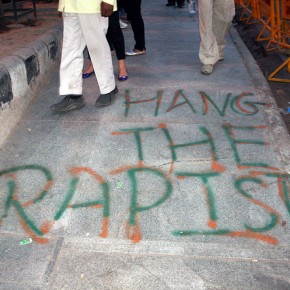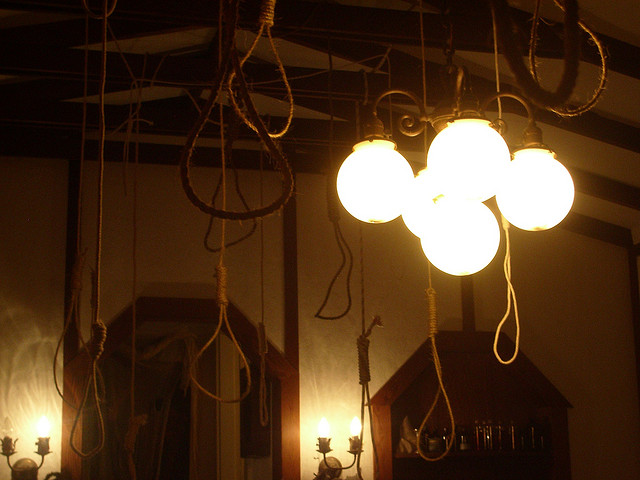Advocating a sex-positive culture is a chore. It’s been over four decades since the Sexual Revolution and its embrace of sensuality and freedom. Yet, despite this opening, sexuality has not been fully emancipated. On the contrary, it has all too often been a tool of the market, and of misogyny.
I was reminded of these conflicting paths by the disturbing Project Unbreakable. The project is curated by Grace Brown, a young photographer who takes and collects photographs of rape survivors holding up posters on which are written phrases the women encountered, uttered by their rapists, or loved ones and authority figures who should have been there to help and support them. Brown’s work is brilliant in its simplicity. But it is also haunting. Particularly striking is how often we hear some of the phrases survivors hold up in the photos in media depictions of men and masculinity.
The photos were striking to me because, in preparation for writing this article, I had been reading through responses to Miley Cyrus’ performance on this year’s MTV Music Video Awards. While it seemed that mainstream media was overwhelming in its puritanical condemnation of Cyrus stripping down and twerking (which, frankly, looked a lot more silly than erotic,) it was largely left to the blogosphere to comment on Robin Thicke, whose song “Blurred Lines,” a virtual anthem of rape justification and misogyny, was the piece Cyrus, with Thicke’s help, performed her act to.
That incident demonstrated a wide range of issues. Miley Cyrus is only the latest woman to realize that sex sells and the market is largely (though not entirely by any stretch) male. However, the outrage she provoked was based on a decidedly conservative worldview, sparked by her having been a child star of the popular pre-teen television series, Hannah Montana. For many who seemed to overlook Thicke’s performance, he was just being “a guy.”
Sexuality in pop culture is something to be encouraged. But given the inevitable commercialization of sex, and anything else that can generate profits in a market-driven society, how can sensuality be expressed in a healthy manner? How can we, on the one hand, encourage healthy expressions of sexuality in all its splendor while doing it in appropriate ways that also combat misogyny?
This is a question that often comes up when some piece of popular media pushes the boundaries of what we are accustomed to encountering. It’s likely to come up again in 2014 when the film version of pulp novel 50 Shades of Grey is released. The popularity of the book, which is written at what might generously be called a grade-school level, has surprised many, and, from what I’ve been given to understand having read only the few chapters I could obtain as a sample, its supposed depiction of a dominant/submissive relationship really isn’t that at all. But the world of kink is precisely the nexus where the question of healthy depictions of sexuality is most crucial.

In 2002, a film called Secretary was released. For many who live “the lifestyle,” it was a welcome positive depiction of a dominant/submissive relationship. For others, it reinforced stereotypes of male oppression of women.
No doubt, Secretary would have had a more powerful message if the gender roles had been reversed, thereby skirting some of the issues of patriarchy that are legitimately raised about the film. Part of the problem is the predisposition toward thinking of the dominant role as “male” and the submissive as “female,” a disposition virtually eternal in media, but far less absolute in real life. But the film exacerbated its own problems.
The female lead, played by Maggie Gyllenhaal, is introduced as someone with deep emotional problems, recently released from a mental ward, a self-injurer. Her boss is almost immediately abusive and their first sexual encounter happens without her consent, though it is retroactively given. Those are very concerning messages. There is no correlation between alternative sexual lifestyles and depression, abuse, or emotional problems any more than those things correlate with “vanilla” sex lives.
Yet by Secretary’s conclusion, the woman’s sexual fulfillment leads her to become a much stronger person. The dominant male is depicted throughout as being as troubled, in his own way, as she is, and in the end needs her to balance him as much, if not more than she needs him. The film, in the end, delivers a very mixed message and, if that is disappointing, it still places it at the pinnacle of depictions of kink relationships in mainstream American cinema.
Bitch Magazine blogger Catherine Scott wrote an eloquent exposition on Secretary last year. “I think the answer lies in the complex character of Lee, who exhibits increasing personal strength as the story progresses,” Scott said. “…Far from being a victim, Lee is the partner who wants more, pushing her dom to the limit with the memorable ‘worm mail’ she sends to provoke him into punishing her…And when Grey (her boss) fires her in order to sever contact, the wallop Lee gives her boss is harder than any of the slaps he’s lavished upon her backside. The trope of unwilling, abused woman and controlling man is certainly inverted in this powerful scene.”
Scott summed up her evaluation of Secretary by saying, “While it could’ve used better power dynamics and more pre-kink negotiation, Secretary was a brave and original step forward in addressing sexual complexity, especially in women.” From what I’ve heard about 50 Shades of Grey (and I doubt the name of the male character in both stories is coincidence) I suspect it will be more troublesome than Secretary was.
These matters are important, because such flawed depictions of relationships that are not the accepted norm reinforce misogyny and patriarchy. The fact that so many of the things I saw written on the posters shown in Project Unbreakable were familiar phrases leads us back to mainstream America, and how it fosters regressive behavior. They gives us a sense of how perpetrators of sexual violence (usually, but not always, men) have had their attitudes reinforced.

We need to start shifting our focus. Miley Cyrus isn’t the problem. Robin Thicke is. Sure, I thought Cyrus’ on-stage twerking looked silly, over the top, even revolting. But no more so than images I see every hour on billboards, in magazines, on television, which might be just as over the top sexually as her performance. It’s Thicke’s sort of cheapness we should be worried about, making light of male attitudes that equate sex with violence—real violence, non-consensual and hurtful.
How do we begin to address that? Sexuality is inevitably connected to the primal. Some kinds of sadomasochism and dominance/submission play (often shortened to BDSM) simply bring that to the fore. Others are much more controlled, staged and planned. In many cases, the two meet. The issue is how we depict sexuality. The best place to start is in the world of kink. Hundreds of millions of people engage in some sort of kink at some time in their lives, and many of them incorporate it into their sex lives.
Yet in media which obsessively try to oversex everything, the depiction of BDSM is completely out of tune with reality. It starts with the gender roles. Male submissives, for example, are rarely shown. When they are, it’s almost always farcical, depicting the submissives as non-masculine. In fact, male submissives, like female ones, are often powerful people who find great release and satisfaction in surrendering control for a while. It continues with depictions that often show the dominant person taking the submissive, without any communication about consent. That’s not how it works in real life, where the BDSM community’s ever-present mantra is “Safe, Sane and Consensual.”
These two ideas, an open sexual culture, and total opposition to rape culture, necessarily go hand in hand. Healthier attitudes about sex and sexual relationships are the best antidote to the dehumanizing culture that nurtures male oppression of women and ends in violation. There are many shocking photos in the Project Unbreakable collection. Some of them depict absolutely horrifying experiences. But too many are familiar because of our media, and they go unnoticed. Robin Thicke’s “Blurred Lines” includes the following lyrics:
I hate these blurred lines
I know you want it
I hate them lines
I know you want it
I hate them lines
I know you want it
But you’re a good girl
That just echoes too many of the posters in Brown’s photos. When Thicke is expressing sexuality with lines like, “I’ll give you something big enough to tear your ass in two,” that’s not a joke. That’s glorifying assault. When we start to realize that such an attitude has no relation to real sexuality, however prurient, we can move toward a sex-positive and anti-rape culture. It seems simple. It ought to be. Because contrary to what men like Robin Thicke think, the line between consent and non-consent isn’t blurry at all.
Photographs courtesy of Joel Schalit





